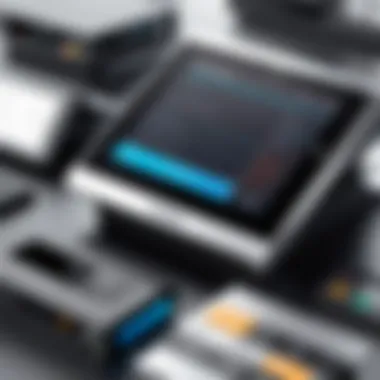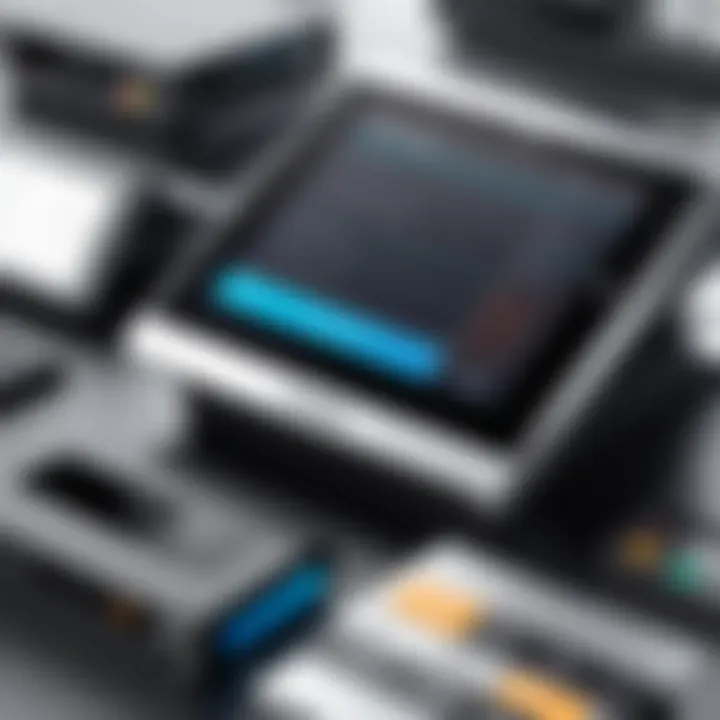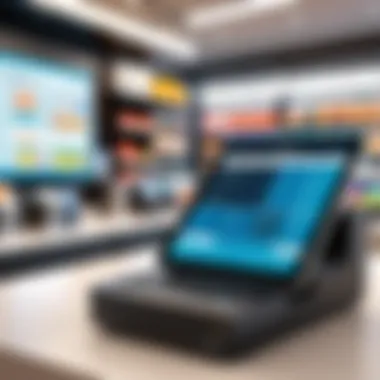Understanding the Functionality of POS Systems


Intro
The evolution of business operations has significantly hinged on the implementation of efficient systems. A Point of Sale (POS) system is one such crucial tool, helping businesses manage transactions, inventory, and customer data effectively. Understanding its functionality and utilization is vital for decision-makers, IT professionals, and entrepreneurs aiming for optimization.
In this article, we will delve into the nuts and bolts of POS systems, exploring core components, functionalities, and implementation strategies. A well-implemented POS system can enhance customer experience and streamline operations. Thus, it is imperative to grasp the underlying fundamentals of these systems to harness their full potential.
Software Overview
Brief Description of Software
A POS system is a combination of hardware and software that facilitates sales transactions. It traditionally includes devices like cash registers, barcode scanners, and printers, but modern POS systems are predominantly software-driven applications. These systems can run on cloud-based solutions or local servers, providing flexibility in terms of accessibility and storage.
Key Features and Functionalities
A robust POS system encompasses several key features that are beneficial across various business environments:
- Transaction Management: Efficiently processes sales transactions, including cash, credit cards, and digital payments.
- Inventory Control: Tracks stock levels, managing reorders and reporting to avoid stockouts.
- Customer Relationship Management (CRM): Helps businesses track customer interactions, preferences, and purchase history, enabling personalized service.
- Reporting and Analytics: Generates insights on sales trends, customer behavior, and inventory status for informed decision-making.
- Integration with Other Systems: Works in conjunction with accounting software and e-commerce platforms, ensuring smooth data flow.
Detailed Comparison
Comparison with Competitors
When selecting a POS system, it is essential to consider how it stacks up against competitors. Notable systems such as Square, Shopify, and Lightspeed have unique strengths. Square is known for its easy setup and lower fees, while Shopify excels in e-commerce integration. Lightspeed offers advanced inventory management, ideal for larger retail operations. This comparison should guide decision-makers to select the right fit based on specific business needs.
Pricing Structure
Pricing for POS systems can vary, influenced by factors such as features, hardware, and subscription models. Some software solutions have a one-time fee, while others operate on a monthly subscription basis:
- Square: No monthly fee for basic services, transaction fees apply.
- Shopify: Monthly subscriptions start from $29, offering different tiers based on needed features.
- Lightspeed: Prices range based on business size, with customized quotes available for larger retailers.
Considering the pricing structure in alignment with available features is critical for making a wise investment.
"Investing in a POS system is not just about handling transactions; it’s about enhancing overall business efficiency."
Prologue to POS Systems
Point of Sale (POS) systems are vital instruments in modern business operations. Their functionality goes beyond simple transactions, providing businesses with essential tools for managing sales, inventory, and customer interactions. Understanding the ins and outs of a POS system is crucial for decision-makers looking to optimize business processes.
A POS system serves as the backbone of retail and service operations, equipping businesses to process sales efficiently and track important metrics. Consequently, recognizing its importance allows leaders to harness its full potential.
Definition of a POS System
A Point of Sale system is defined as a combination of hardware and software that allows businesses to complete sales transactions. Typically, the hardware components of a POS include terminals, card readers, and printers. The software aspect often integrates functionalities such as inventory management and customer database tracking.
In essence, a POS system serves as the digital cash register, turning every sales interaction into actionable data.
Importance in Business Operations
The role of POS systems in business operations cannot be overstated. They streamline processes, reducing the time needed for sales transactions. Moreover, a reliable POS system enhances customer service. Customers can check out quickly and conveniently, leading to increased customer satisfaction.
Benefits of utilizing a POS system include:
- Improved transaction speed, allowing for more customers served in less time.
- Enhanced data tracking, giving businesses insights into sales trends and inventory levels.
- Integration capabilities with other business solutions, ensuring seamless operations.
"Investing in a sophisticated POS system can often lead to a significant return on investment through improved operational efficiency."
In summary, POS systems contribute significantly to the efficiency and success of businesses today. They are not just tools for processing payments but are essential platforms for engaging customers and managing operations.
Components of a POS System
The effectiveness of a Point of Sale (POS) system hinges on its components. These elements form the backbone of operation, allowing businesses to process transactions, manage inventory, and maintain customer relationships efficiently. Understanding the components is essential for selecting the right system, optimizing workflows, and ultimately enhancing the customer experience. For any business looking to invest in a POS system, knowing the ins and outs of these components can mean the difference between seamless operations and costly disruptions.
Hardware Elements
The hardware aspects of a POS system are crucial in physical transaction environments. Each hardware element plays a distinct role in facilitating sales and securing payments. Below are key hardware elements that every business should consider when implementing a POS system.
Terminals
Terminals serve as the main interface for cashiers during sales transactions. They process payments and can display product information. A key characteristic of terminals is their user-friendliness, allowing quick and effective transactions. Terminals can integrate with various peripherals, such as scanners and printers, making them a versatile choice for many businesses. They often come equipped with touch screens, simplifying the operation for employees. However, some may find their initial cost high. Businesses must balance cost with long-term benefits and efficiency gains.
Printers
Printers in a POS system generate receipts for customer transactions and other crucial documents. They can be thermal or impact printers. A significant attribute of thermal printers is their speed, enhancing the overall efficiency of checkout processes. These printers are typically low-maintenance and provide crisp, clear print quality. However, they may reveal their limitations in durability, especially in high-volume environments. Businesses need to weigh the speed against any potential longevity issues when choosing the right printer for their needs.
Card Readers
Card readers enable electronic payment processing, accommodating various payment methods such as credit and debit cards. They are essential for ensuring that transactions remain secure and efficient. The key feature of modern card readers is their ability to accept contactless payments, which enhances speed during checkout. This technology minimizes wait times for customers, making it a popular choice. Nevertheless, businesses must consider the data privacy concerns tied with electronic payments and ensure compliance with regulations, which can add complexity.
Scanners
Scanners are used to quickly read barcodes on products, significantly reducing check-out times. A primary characteristic of scanners is their accuracy and efficiency, enhancing customer satisfaction. By streamlining the scanning process, they provide valuable speed advantages over manual input. Various types of scanners exist, from handheld to fixed-position scanners. A disadvantage might include the need for maintenance, as misreads can occasionally occur, leading to potential delays. Careful selection based on usage frequency and settings is crucial.
Software Integrations


Alongside hardware, software integrations form the digital structure of a POS system. They enhance operation by connecting various business functions such as inventory and customer management. Choosing the right software is key to maximizing the benefits of a POS system.
Inventory Management
Inventory management software is vital for keeping track of stock levels in real-time. This integration helps businesses avoid overstocking or running out of popular items. A standout feature is automated stock updates, which synchronize with sales data. This ensures that businesses have an accurate inventory count without tedious manual checks. However, setting up this software can become complex, requiring time and effort to ensure it aligns perfectly with the business's needs.
Customer Relationship Management
Customer relationship management (CRM) software enhances how businesses engage with customers. It collects data on customer preferences and purchase history, allowing for tailored marketing efforts. This software is beneficial as it fosters loyalty through personalized experiences. Yet, the integration process can sometimes be cumbersome, requiring adequate training for staff to use effectively. The potential for increased sales makes it a worthy investment despite these challenges.
Accounting Software
Accounting software streamlines financial processes, ensuring accuracy in transaction recording and reporting. A significant characteristic here is automation, which reduces human error and saves time for finance teams. The integration contributes to easier tax preparation and more detailed financial insights. However, businesses must ensure that their accounting software can integrate seamlessly with their POS for optimal operation. Choosing the right accounting software often requires thorough evaluation to match financial needs and complexity.
Types of POS Systems
Understanding the different types of POS systems is crucial for business owners and decision-makers. Each system has distinct functionalities and benefits that fit various business models. Choosing the right type can improve efficiency, enhance customer experience, and streamline operations. Here, we will explore three primary categories of POS systems: traditional, cloud-based, and mobile.
Traditional POS Systems
Traditional POS systems are the classic setup found in many retail environments. These systems are primarily hardware-based and often include components such as cash registers, barcode scanners, and receipt printers. Typically, the software is installed on a specific terminal situated in the store.
Key Benefits:
- Reliable Performance: Since they operate independently of network connections, traditional systems are less prone to disruptions caused by internet outages.
- Security: Data from transactions is stored on-site, which can provide a sense of control over sensitive customer information.
However, they have limitations. They can be less flexible compared to newer systems, requiring significant investment in hardware and maintenance. Updates and new features are often dependent on vendor schedules, which can slow down responsiveness to changing business needs.
Cloud-Based POS Systems
Cloud-based POS systems are becoming increasingly popular among modern retailers. These systems operate via the internet and store data in the cloud. This connectivity provides access to real-time inventory data and sales analytics from anywhere, as long as there is an internet connection.
Key Benefits:
- Access from Anywhere: Decision-makers can view sales reports, manage inventory, and track customer interactions from remote locations.
- Scalability: These systems can grow with a business. Adding locations or new features can often be done with minimal disruption to operations.
However, reliance on internet connectivity can be a concern, as outages may impact access to vital functions. Data security in the cloud is another consideration, requiring strong measures to protect sensitive information.
Mobile POS Systems
Mobile POS systems have gained traction, especially in service-oriented industries. These systems allow transactions to take place anywhere within a business using smartphones or tablets. Mobile apps facilitate sales, inventory management, and customer interactions in real-time.
Key Benefits:
- Enhanced Customer Experience: Customers appreciate the personalized service when associates can assist them directly at the point of sale.
- Increased Efficiency: Mobile systems reduce wait times and can streamline the checkout process in busy retail environments.
On the downside, mobile systems may lack some features included in traditional or cloud-based setups. Battery life is a concern during high-traffic periods, and security risks may arise from the use of unsecured devices.
In summary, understanding the types of POS systems allows businesses to make informed decisions tailored to their specific needs. Each type brings its own strengths and weaknesses, highlighting the importance of conducting a comprehensive evaluation before selection.
Setting Up a POS System
Setting up a POS system is a crucial step for businesses aiming to streamline operations and enhance customer experience. The correct implementation of such systems allows for better transaction handling, inventory tracking, and financial reporting. This section will delve into the specific elements, benefits, and considerations that need to be addressed during the setup process.
Choosing the Right POS Software
Choosing suitable POS software is foundational to a successful system setup. A well-chosen software aligns with business objectives and enhances operations.
Evaluating Business Needs
Evaluating business needs is important. It involves assessing what features are essential for efficient transactions and management. Each business has unique requirements. For instance, a restaurant would prioritize table management and menu customization, while a retail store might focus on inventory tracking and sales reporting. By understanding specific business needs, organizations can select software that not only fits their model but also scales as they grow.
Key characteristic: Customizability. Businesses benefit from software that can be tailored to their specific operations.
One unique feature is the ability to integrate with other tools. This reduces redundancy and enhances data accuracy. Overall, evaluating business needs helps ensure the POS system is a fit, ultimately reducing frustration and increasing productivity.
Comparing Features
Comparing features amongst various POS software solutions is essential. This step contributes directly to the overall goal of finding the right package that meets both current and future needs.
Key characteristic: Comprehensive feature lists. A beneficial aspect of this is that it helps decision-makers avoid unnecessary costs associated with features that are not needed. When comparing, one should look at aspects like user interface, ease of use, and customer support.
Unique features include reporting capabilities, which enable businesses to analyze sales patterns and customer behavior. This can lead to better decision-making. However, the downside can be an overwhelming number of options that may confuse stakeholders if not properly categorized.
Installation Process
The installation process has two primary components: hardware setup and software installation. Each stage is critical to ensure everything functions smoothly.
Hardware Setup
Hardware setup involves the physical installation of devices like terminals, printers, and card readers. This is a practical aspect that can influence the overall efficiency of the system. Proper positioning of hardware minimizes the risk of connectivity issues later.
Key characteristic: Ergonomics. A well-organized workspace can enhance speed in customer transactions.


One unique feature of hardware setup is the ability to integrate diverse devices. For example, a barcode scanner should work seamlessly with the main terminal. If configured poorly, it can lead to delays that frustrate both customers and staff.
Software Installation
Software installation is equally important as it sets the functionality in motion. This aspect gives businesses the tools needed for operations.
Key characteristic: User accessibility. Well-designed software should be straightforward, minimizing the learning curve for staff.
A unique advantage is cloud-based solutions, which can update automatically, ensuring the system operates on the latest features. However, there can be disadvantages if hardware does not meet the system requirements, leading to performance issues.
Employee Training
Employee training is the final piece of setup. Having a sophisticated system is not enough if staff is not proficient in using it. Training ensures all employees can operate the system effectively, reducing errors and improving customer interactions.
Moreover, investing time in training shows staff the value of the POS system, which can enhance morale and productivity. Training should cover not just basic operations, but also troubleshooting common issues. This equips employees to handle unexpected situations, leading to a more robust operational environment.
Utilizing POS Systems in Business
The integration of Point of Sale (POS) systems into business operations is a significant step that influences productivity and customer satisfaction. These systems streamline numerous functions that can lead to operational excellence. By understanding the functionality and utilization of POS systems, businesses can leverage the technology to improve daily transactions, enhance customer experiences, and gain insights from data analytics.
Daily Operations Management
Managing daily operations effectively is essential for any business. A POS system plays a critical role in this process. It automates various tasks such as inventory tracking, sales monitoring, and employee management. With real-time updates, it minimizes the risk of errors. For example, as inventory levels deplete, the system can trigger alerts to reorder items. This ensures that businesses always have necessary products on hand without overstocking.
Benefits of daily operations management with POS systems include:
- Efficiency: Automation reduces manual tasks, allowing employees to focus on customer service.
- Accuracy: Real-time updates minimize counting errors during inventory checks.
- Productivity: Employees can serve customers faster, leading to enhanced sales opportunities.
Customer Transactions
Customer transactions form the heart of any retail or service operation. A POS system facilitates seamless checkout experiences. From scanning items to processing payments, every step is optimized. Modern POS systems support various payment methods, such as credit cards, mobile wallets, or even gift cards. This flexibility caters to customers' preferences and encourages them to make purchases.
Moreover, many POS systems can store customer data. This enables businesses to track purchasing behavior and tailor marketing efforts. By offering personalized promotions, businesses can foster loyalty.
"Providing various payment options and personalized offers can significantly improve the customer experience."
Reporting and Analytics Features
Utilizing POS systems goes beyond handling sales. They provide insightful reports that inform business strategies. By analyzing sales data, businesses can identify trends, seasonal demands, and inventory performance.
Some critical reporting features in a POS system include:
- Sales Reports: Track revenue over time, helping make informed decisions about staffing and inventory.
- Customer Reports: Analyze customer buying behavior to create targeted marketing campaigns.
- Inventory Reports: Monitor stock levels and predict reorder points, reducing excess inventory costs.
These analytical capabilities help businesses optimize operational strategies, ultimately leading to increased profitability.
In summary, effectively utilizing a POS system is crucial for advancing business operations. It enhances daily management, promotes smooth customer transactions, and offers actionable insights through data analysis. By adopting a comprehensive approach to utilizing POS systems, businesses position themselves for long-term success.
Troubleshooting Common POS Issues
Troubleshooting common POS issues is a critical aspect of maintaining operational efficiency in retail and various business environments. Understanding the potential problems that can arise with Point of Sale systems empowers businesses to address these effectively. Pos systems are integral for processing sales and managing customer interactions, so any disruption can impact revenue and customer satisfaction.
Identifying and resolving these issues promptly can minimize downtime, enhance user experience, and optimize the overall effectiveness of the system. This section delves into three prevalent types of problems: hardware failures, software glitches, and connectivity issues, presenting practical strategies for diagnosis and resolution.
Hardware Failures
Hardware failures can severely disrupt service at the checkout line. Problems may arise in terminals, printers, card readers, or scanners, which are all essential components of a POS system. Common signs of hardware issues might include an unresponsive touchscreen, failure to print receipts, or a card reader not accepting payment.
Key considerations in managing hardware failures:
- Routine Maintenance: Regular checks on hardware can prevent unexpected breakdowns.
- Manufacturer Support: Keeping contacts for manufacturers or service providers handy is crucial for quick assistance.
- Replacement Parts: Maintain a stock of critical spare parts to ensure rapid repairs when failures occur.
Common hardware issues include:
- Faulty cables or connections leading to printer or terminal failures.
- Misalignment in barcode scanners that can hinder reading barcodes.
- Hardware incompatibility with current software or updates.
Addressing these problems might require hands-on intervention or professional help, depending on the complexity of the system involved.
Software Glitches
Software glitches can occur due to numerous factors, including updates, bugs, and compatibility issues. These problems may manifest as slow processing times, error messages during transactions, or unexpected logouts. They can significantly hinder business operations, causing frustration for staff and customers alike.
To manage software glitches effectively:
- Regular Updates: Ensure your POS software is up to date with the latest version to include important patches and feature improvements.
- Backup Systems: Regularly back up your data to prevent loss during technical difficulties.
- Vendor Communication: Maintain open channels with your software provider for rapid troubleshooting assistance.
Common software issues include:
- Outdated software causing incompatibility with newer hardware.
- Bugs that lead to transaction errors or incorrect inventory counts.
- Security vulnerabilities that result in data breaches or system exploitation.
Identifying the root cause often involves checking logs and interacting with support teams to rectify the problem.
Connectivity Problems


Connectivity issues can disrupt the communication between POS terminals and payment processors, as well as the infrastructure linking different POS hardware and software components. These problems may manifest as slow transaction processing, failure to connect to payment networks, or unresponsive systems.
To troubleshoot connectivity problems effectively:
- Network Assessment: Regularly assess your network performance, ensuring adequate bandwidth and stability for your POS operations.
- Backup Connectivity Solutions: Consider alternate methods such as mobile data connections for critical services if the primary network fails.
- Hardware Configuration: Ensure that all devices are appropriately configured to connect to the network.
Common connectivity issues include:
- Poor Wi-Fi signals affecting transaction times.
- Firewall settings unintentionally blocking communications with payment processors.
- Outdated routers or switches hindering network performance.
Addressing connectivity problems necessitates both technical knowledge and the ability to perform diagnostic checks on the system to ensure smooth operation.
Advanced Features of POS Systems
Advanced features of POS systems play a critical role in enhancing business operations. These functionalities improve customer experiences and streamline various business processes. They allow businesses to remain competitive in a rapidly changing market by adapting to evolving consumer behaviors and technology trends. Therefore, understanding these features is crucial for decision-makers, IT professionals, and entrepreneurs aiming to maximize the potential of their POS systems.
Loyalty Program Management
Loyalty program management is an essential aspect of modern POS systems. This feature enables businesses to create customized loyalty programs that reward customers for repeat purchases. Through effective loyalty programs, businesses can increase customer retention and build lasting relationships.
Key benefits include:
- Tracking customer purchases for tailored rewards.
- Encouraging higher spending by offering incentives.
- Collecting meaningful data about customer preferences.
Consideration in implementing loyalty programs includes ensuring they are simple for customers to understand. The easier the program is to navigate, the more likely customers will engage. Additionally, integration with existing POS functions ensures that rewards are automatically applied during transactions, fostering a seamless experience for both customers and staff.
Mobile Payment Solutions
The integration of mobile payment solutions into POS systems represents a significant advancement in transaction processing. This feature allows businesses to accept payments through mobile wallets such as Apple Pay and Google Pay. The result is convenience for customers and potentially reduced transaction times.
Benefits of mobile payment solutions include:
- Enhancing customer convenience and satisfaction.
- Reducing the need for cash handling, which may decrease theft risk.
- Streamlining transactions, which may lead to faster service.
For businesses, adopting mobile payment solutions can also broaden the customer base. As more consumers prefer digital payments, companies that embrace this technology are likely to achieve better sales performance. Choosing a POS system that supports multiple mobile payment options can therefore serve as a competitive edge.
Integration with E-commerce Platforms
Integrating POS systems with e-commerce platforms is vital for businesses operating both physical stores and online. This feature allows for centralized inventory management and unified customer data across channels. As a result, businesses can offer a cohesive shopping experience, irrespective of where the transaction occurs.
Key advantages of integration include:
- Real-time inventory updates that prevent stock discrepancies.
- Improved customer insights from consolidated data analysis.
- Enhanced marketing capabilities through targeted promotions based on customer shopping habits.
Important considerations for successful integration focus on choosing POS software compatible with e-commerce platforms. Companies should ensure that all channels communicate effectively to provide a seamless experience for customers. An effective integration strategy not only streamlines operations but also ultimately leads to improved customer satisfaction.
Measuring POS System Performance
Measuring the performance of a POS system is an essential task that ensures efficiency and productivity within a business. A POS system is not merely a tool for transactions but also a crucial component that influences overall business success. Effectively measuring its performance helps identify areas of strength and spots that require improvement. Organizations must focus on several key aspects such as transaction speed, user satisfaction, and the accuracy of sales data. Monitoring these metrics can lead to better decision-making and optimized operations.
Key Performance Indicators (KPIs)
Key Performance Indicators serve as quantifiable measures that help assess how effectively the POS system is achieving business objectives. Here are some important KPIs to consider:
- Transaction Volume: This measures the total number of transactions processed during a specific period. It can help in understanding customer behavior and peak times.
- Average Transaction Value: Assessing the average value per transaction helps evaluate the spending habits of customers, informing pricing or promotional strategies.
- Transaction Time: Monitoring how long it takes to process a sale is critical. A lengthy transaction time may indicate inefficiencies that need addressing.
- System Downtime: Recording how often and how long the POS system is non-functional provides insight into reliability.
By regularly tracking these KPIs, businesses can identify trends and make adjustments to enhance the overall performance of their POS systems.
User Feedback and Adaptation
User feedback plays a pivotal role in refining the utilization and functionality of a POS system. Gaining insights from users — whether they are employees or customers — leads to stronger engagement with the system itself. Here are some considerations for gathering and implementing user feedback:
- Surveys and Questionnaires: Regularly circulate surveys to collect opinions and experiences of users. This data can inform necessary updates or modifications.
- Direct Communication: Encourage open discussions between users and management to tackle specific concerns or suggestions.
- Monitoring User Behavior: Observing how employees interact with the POS can reveal usability issues, prompting adjustments to training or software features.
Adaptation based on user feedback not only enhances the system's functionality but can also significantly improve user satisfaction, leading to better customer service overall.
Future Trends in POS Technology
The landscape of Point of Sale (POS) technology is evolving rapidly. This section sheds light on the future trends shaping the efficiency and effectiveness of POS systems. As businesses strive to enhance customer experiences and streamline operations, understanding these trends becomes increasingly vital. These developments not only optimize transactional activities but also offer significant advantages to business owners and operators.
Integration with Artificial Intelligence
One of the most significant shifts in POS technology is the integration of artificial intelligence (AI). This integration allows businesses to harness large data sets, providing meaningful insights about customer behavior and operational efficiency. AI can analyze purchasing patterns, allowing businesses to create personalized marketing strategies tailored to individual preferences.
Some benefits of AI integration include:
- Improved inventory management through predictive analytics.
- Efficient customer service through chatbots and virtual assistants.
- Enhanced fraud detection by monitoring abnormal transaction patterns.
Adopting AI in POS systems can yield competitive advantages. Companies that leverage AI can anticipate customer needs, improve recommendations, and ultimately increase sales.
Increased Mobility and Flexibility
Another trend is the move towards increased mobility and flexibility in POS solutions. Traditional POS systems often have rigid configurations and require specific hardware setups. However, the shift to mobile POS systems allows transactions to occur anywhere, not just at a fixed register. This flexibility is vital, especially for businesses in retail and hospitality sectors.
Benefits of mobile POS solutions include:
- Enhanced customer engagement as staff can interact with customers throughout the shopping experience.
- Faster checkout processes, reducing lines and wait times.
- Easier management for outdoor or pop-up events, ensuring payment capabilities in various settings.
This mobility not only caters to customer convenience but also enables businesses to manage operations more efficiently. It opens new avenues for operational strategies, ensuring adaptability in a changing marketplace.
"The integration of AI and mobile solutions in POS systems is not just a trend—it's a critical evolution in how businesses interact with their customers and manage their operations."
As these trends continue to develop, businesses need to stay informed and adaptable, ensuring they take full advantage of the advancements presented by modern POS technology.







